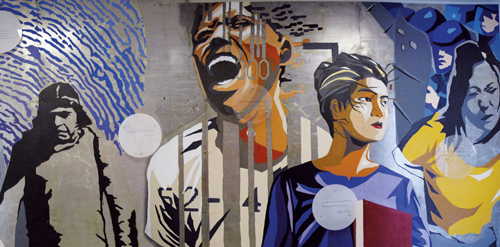Exhibit honors UCLA ethnic studies

This mural, “Education Through Struggle,” was painted by artist Darryl Mar and UCLA students in 1995. It is located at the Asian American Studies Center in Campbell Hall. This is just one example of the art that will be on display to honor 40 years of ethnic studies at UCLA.
By Aly Holmes
Feb. 25, 2010 9:00 p.m.
Forty years ago, college campuses across the nation were in uproar as the call for civil rights became louder.
Students and faculty at UCLA took this need for diversity and worked to establish programs that continue to make contributions to ethnic studies around the world. “Art, Activism, Access: 40 Years of Ethnic Studies at UCLA” honors the contribution of the ethnic studies centers to UCLA. The exhibit takes place at the Fowler Museum of Cultural History and runs from Sunday to June 13.
“The country was at an extremely polarized juncture. Those who were marginalized were determined to seek rights,” said Claudia Mitchell-Kernan, vice chancellor of the UCLA graduate division.
To address this problem, students joined with professors and Chancellor Charles Young to create ethnic studies centers. The Ralph J. Bunche Center for African American Studies was the first ethnic studies center, and was soon followed by the American Indian Studies Center, Asian American Studies Center, and Chicano Studies Research Center. These contributions have been compiled to represent how the ethnic studies centers have affected UCLA. The photos, art, films and other material were taken from the centers’ archives, other parts of campus and the Los Angeles Public Library.
“The primary goals of ethnic research centers are the creation of new knowledge, studying problems communities face and raising awareness of these groups,” said Belinda Tucker, an associate dean of the graduate division.
Instead of looking inward as a campus-based department, the program instead reached outward to the greater communities on a local and international level. Research was not the only focus of the ethnic studies centers.
“The other thing that the center did was negotiating with administration to create faculty slots in other departments. The consequence of this was creating diversity within another discipline,” Tucker said.
This helped create a very different environment on campus, which in turn attracted a student body from a multitude of different backgrounds.
“The establishment of the research centers created another kind of understanding that embraced many histories,” said Betsy Quick, the director of education for the Fowler Museum.
These contributions have not gone unnoticed.
“We want to celebrate all that the centers have contributed to the community,” Tucker said.
Art was chosen as the best way to acknowledge the achievements of the ethnic research centers.
“We sought out objects with remarkable graphics and point to a time when students and faculty were actually making a change,” Quick said.
These pieces include “Life in a Day in Black L.A.” which is a series of photos that document life in black communities in Los Angeles after the Los Angeles Riots in 1992.
Another highlight is a mural with an intriguing past.
“Two young men at age 14 painted the mural when they attended a summer session. Throughout time the identity of the painters was lost. One of the painters, Richard Wyatt, … saw the mural in one of our mailings, contacted me and identified himself as the artist,” Quick said.
The exhibition also provides an opportunity to hear some of the people who established the centers speak. While the centers have made many contributions to the communities they serve, they still remain true to the original goals.
“We need to be aware that the struggle is not complete. We all wish for a more just society,” Vice Chancellor Mitchell-Kernan said.
“This represents to many of us the contributions we have made towards that end.”


